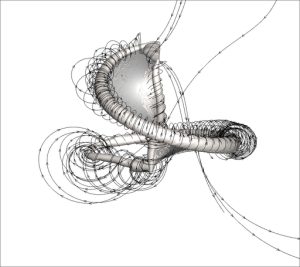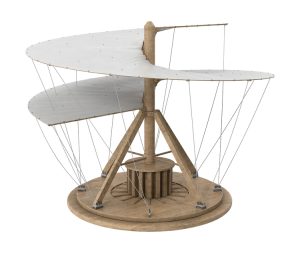
The FAA receives thousands of complaints every year about the loud buzzing produced by drone propellers slicing through the air. Experts believe noise pollution caused by these unmanned aerial vehicles will only worsen as they are increasingly used for package delivery, emergency response, and more.
A research team led by mechanical engineering professor Rajat Mittal believes a device invented by Leonardo da Vinci more than 500 years ago may hold the key to quieter drones. “da Vinci’s visionary aerial screw—a sort of precursor to the modern helicopter—inspired our investigation,” says Mittal, whose mechanical engineering team included Jung-Hee Seo, an associate research professor, and doctoral candidate Suryansh Prakhar. The researchers published their findings in Bulletin of the American Physical Society.
The team was aware that other research groups had explored loop-shaped propellers that were less noisy than traditional propellers that have flat, thin blades and angled edges. The characteristic buzzing sound produced by traditional propellers is the result of “tip vortices”—small swirling tornadoes of air that whoosh and intersect with the flat, angled blades. Loop propellers spread those vortices around, muting the sound.
Mittal’s team thought that da Vinci’s design, with its screw-like shape and single blade, might be quieter, too. To start, the researchers created a model, building on the work of aerospace engineering students at the University of Maryland, who had analyzed the aerial screw’s design, including its radius, curve, pitch, shape, and number of loops.
“We constructed a 3D model of the da Vinci aerial screw’s looped shape, and then used our simulation software, called ViCar3D, to simulate the flow of air around
the rotor as the drone was hovering in place. The software then predicted the speed of airflow around the propeller and pressure patterns,” says Prakhar.
The pressure generated on the rotating screw’s surface would turn into sound, so the team calculated the noise produced five meters from the rotor. Then they simulated the loop propeller in the same circumstances.
The da Vinci propeller was, in fact, a bit noisier than the loop propeller at any given rotation speed, but the aerial screw also produced more lift. Knowing the amount of lift needed to remain fixed for common drone assignments, the team then calculated the noise emitted by the da Vinci and loop propellers when producing the same amount of lift and had their answer.
“The da Vinci propeller produced much less noise for the same given amount of lift being generated,” Prakhar says.





